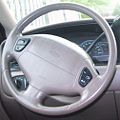2000 Ford Windstar Owner Guide 1st Printing - Page 230
2000 Ford Windstar Manual
Page 230 highlights
Maintenance and care SNOW TIRES AND CHAINS Driving too fast for conditions creates the possibility of loss of vehicle control. Driving at very high speeds for extended periods of time may result in damage to vehicle components. Snow tires must be the same size and grade as the tires you currently have on your vehicle. The tires on your vehicle have all weather treads to provide traction in rain and snow. However, in some climates, you may need to use snow tires and chains. If you need to use chains, it is recommended that steel wheels (of the same size and specifications) be used as chains may chip aluminum wheels. Follow these guidelines when using snow tires and chains: • Do not use tire chains with size P225/60R16 or P215/70R15 tires. • Use only SAE Class S chains. • Install chains securely, verifying that the chains do not touch any wiring, brake lines or fuel lines. • Drive cautiously. If you hear the chains rub or bang against your vehicle, stop and re-tighten the chains. If this does not work, remove the chains to prevent damage to your vehicle. • If possible, avoid fully loading your vehicle. • Remove the tire chains when they are no longer needed. Do not use tire chains on dry roads. • The suspension insulation and bumpers will help prevent vehicle damage. Do not remove these components from your vehicle when using snow tires and chains. WHAT YOU SHOULD KNOW ABOUT AUTOMOTIVE FUELS Important safety precautions Do not overfill the fuel tank. The pressure in an overfilled tank may cause leakage and lead to fuel spray and fire. 230
















